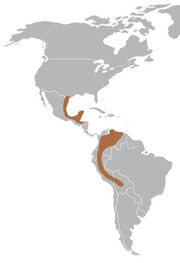
Green Jay (luxuosus group)
The Green Jay (Cyanocorax yncas) is a member of the Corvidae family. It is a New World jay. While found primarily in Mexico and South America, the Green Jay is also present in southern Texas. It has been suggested that the North American taxa should be considered a separate species. If one follows this proposed classification, then the North American population retains the common name of Green Jay, while the South American population is called the Inca Jay. Regardless of what one calls the bird, it retains the scientific name of Cyanocorax yncas.
Appearance[]

Inca Jay at Cerro El Ávila, Venezuela
The Green Jay is a large songbird that is 29 cm (11 in) long and weighs 66-110 g (2.33-3.88 ounces), with a wingspan of 38 cm (15 in). Both sexes are alike in physical description. Green Jays have yellowish-white feathers with blue tips on the top of the head, the cheeks and the nape. Some taxa have more blue than others, and the crown can appear almost completely white in some South American subspecies. A thick, black bib reaches up to the sides of the head, and across the eyes. In the most northern part of its range, the back and the underside are pale green, while the sides of the tail are yellow. Elsewhere, its breast and underparts are typically bright to dull yellow, with the back being a rich green. The Green Jay has large nasal bristles that form a distinct tuft in some subspecies, but are less developed in others. Depending on the subspecies, its eye color can be a dark brown to a bright yellow. The plumage of the juveniles is a slightly duller variant of the adults.
Voice[]
The Green Jay can make an extensive variety of vocalizations. The most common calls are the harsh, nasal "eenk, eenk, eenk, eenk" and the higher "stick, stick, stick". Also in its repertoire are squeaky noises and frog-like croaks.
Range and Habitat[]

Geographical Range
The Green Jay shows distinct regional variations within its large but discontinuous range. This range stretches from southern Texas south into Mexico and Central America, with a break before the species reappears in a broad sweep across the highlands of South America in Colombia, Venezuela, Ecuador, Peru and Bolivia. While the Green Jay prefers dense riparian woods and woodland edges, it can be found wherever there is sufficient cover. Its territory can be in open woodlands, thickets and humid forests.
Assumed predators of Green Jays are birds of prey and owls. Their conservation status is of Least Concern.
Diet[]
The Green Jay feeds on a wide range of incests and other invertebrates, as well as acorns, various cereal grains, and fruit. Ebony seeds are a food source where these occur. When the opportunity presents itself, meat and human scraps add to the bird's diet. The Green Jay has been observed using sticks as tools in order to extract insects from tree bark.
Reproduction[]
The breeding season lasts from April to June. The Green Jay usually builds a nest in a tree, a thorny bush, or a thicket. This nest is an open cup of thorny twigs, lined with fine roots, vine stems, moss, and dry grass. The female lays three to five pale, greenish-white eggs with dark spots near the base, and incubates the eggs on her own. After seventeen days, the chicks will hatch. At this time the chicks are naked and helpless, and are tended to by both the mother and father. On becoming fledglings, the parents and any helpers will continue to feed the chicks for another three weeks.
The southern Texas population of Green Jay is unusual in its treatment of related non-breeders. Family flocks will retain the one-year-old non-breeding jays from the previous year's reproductive effort despite that the non-breeders do not help feed the nestlings. In this region, the family flock consists of a breeding pair, the current year's nestlings, and the one-year-old jays from the last year. The one-year-old's provide a significant amount of territorial defense, which aids the parents, before being ejected from the family flock soon after the current year's nestlings have fledged. By contrast, the Colombian population of Green Jay practices cooperate breeding, with the one-year-old's from the last year helping to feed the current year's nestlings. The difference is apparently related to food resources being less abundant and more unevenly distributed in that region.

